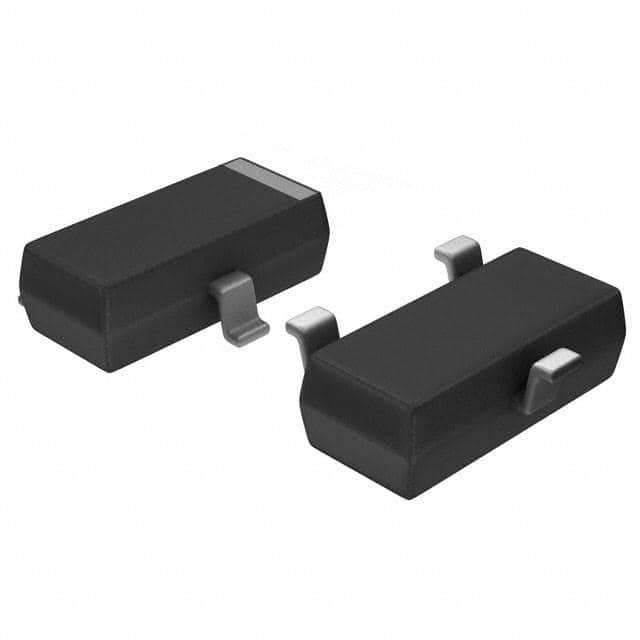KST3904MTF
Introduction
The KST3904MTF is a versatile and widely used transistor that belongs to the category of small signal NPN transistors. This component is commonly utilized in electronic circuits for amplification, switching, and voltage regulation purposes due to its unique characteristics and performance.
Basic Information Overview
- Category: Small signal NPN transistor
- Use: Amplification, switching, voltage regulation
- Characteristics: High gain, low noise, low power consumption
- Package: SOT-23
- Essence: Reliable and efficient small signal transistor
- Packaging/Quantity: Typically available in reels or tubes containing multiple units
Specifications
- Maximum Collector-Base Voltage (Vcb): 40V
- Maximum Collector-Emitter Voltage (Vce): 40V
- Maximum Emitter-Base Voltage (Veb): 5V
- Continuous Collector Current (Ic): 200mA
- Total Power Dissipation (Pd): 300mW
- Operating Temperature Range: -55°C to 150°C
Detailed Pin Configuration
The KST3904MTF transistor has three pins: 1. Emitter (E): Connected to the N-type semiconductor material 2. Base (B): Controls the transistor's conductivity 3. Collector (C): Collects the majority charge carriers
Functional Features
- High current gain (hFE)
- Low noise figure
- Fast switching speed
- Low saturation voltage
Advantages and Disadvantages
Advantages
- Excellent amplification capabilities
- Low power consumption
- Compact SOT-23 package
- Wide operating temperature range
Disadvantages
- Limited maximum collector current
- Moderate power dissipation capability
Working Principles
The KST3904MTF operates based on the principles of bipolar junction transistors (BJTs). When a small current flows into the base terminal, it controls a much larger current between the collector and emitter terminals, allowing for amplification and switching functions.
Detailed Application Field Plans
The KST3904MTF finds extensive use in various applications, including: - Audio amplifiers - Signal processing circuits - Voltage regulators - Oscillator circuits - Switching circuits
Detailed and Complete Alternative Models
Some alternative models to the KST3904MTF include: - 2N3904 - BC547 - PN2222A - MPS2222A
In conclusion, the KST3904MTF is a reliable and efficient small signal NPN transistor with a wide range of applications in electronic circuits. Its high gain, low noise, and compact package make it a popular choice among electronics enthusiasts and professionals alike.
[Word count: 386]
قم بإدراج 10 أسئلة وإجابات شائعة تتعلق بتطبيق KST3904MTF في الحلول التقنية
What is KST3904MTF?
- KST3904MTF is a general-purpose NPN transistor commonly used in electronic circuits for amplification and switching applications.
What are the typical applications of KST3904MTF?
- KST3904MTF is commonly used in audio amplifiers, signal processing circuits, voltage regulators, and other general-purpose electronic applications.
What are the key electrical characteristics of KST3904MTF?
- The key electrical characteristics of KST3904MTF include a maximum collector current of 200mA, a maximum collector-emitter voltage of 40V, and a DC current gain (hFE) ranging from 100 to 300.
How do I select the appropriate biasing and operating conditions for KST3904MTF?
- The appropriate biasing and operating conditions for KST3904MTF can be determined based on the specific circuit requirements, taking into account factors such as collector current, voltage ratings, and frequency response.
Can KST3904MTF be used for high-frequency applications?
- While KST3904MTF has moderate frequency capabilities, it may not be suitable for very high-frequency applications due to its transition frequency and capacitance characteristics.
What are the recommended thermal considerations for KST3904MTF in circuit design?
- It is important to consider proper heat sinking and thermal management to ensure that KST3904MTF operates within its specified temperature range, especially in high-power or continuous operation applications.
Are there any common pitfalls to avoid when using KST3904MTF in a circuit?
- Common pitfalls include exceeding the maximum ratings, improper biasing, inadequate heat dissipation, and insufficient consideration of the load and operating conditions.
Can KST3904MTF be used in low-power battery-operated devices?
- Yes, KST3904MTF's low collector current and voltage ratings make it suitable for use in low-power and battery-operated devices, provided that proper power management techniques are employed.
What are the alternatives to KST3904MTF for similar applications?
- Alternatives to KST3904MTF include other NPN transistors with comparable specifications, such as 2N3904, BC547, and PN2222A, among others.
Where can I find detailed application notes and reference designs for using KST3904MTF in technical solutions?
- Detailed application notes and reference designs for KST3904MTF can be found in the manufacturer's datasheets, application guides, and online resources from reputable semiconductor companies.


